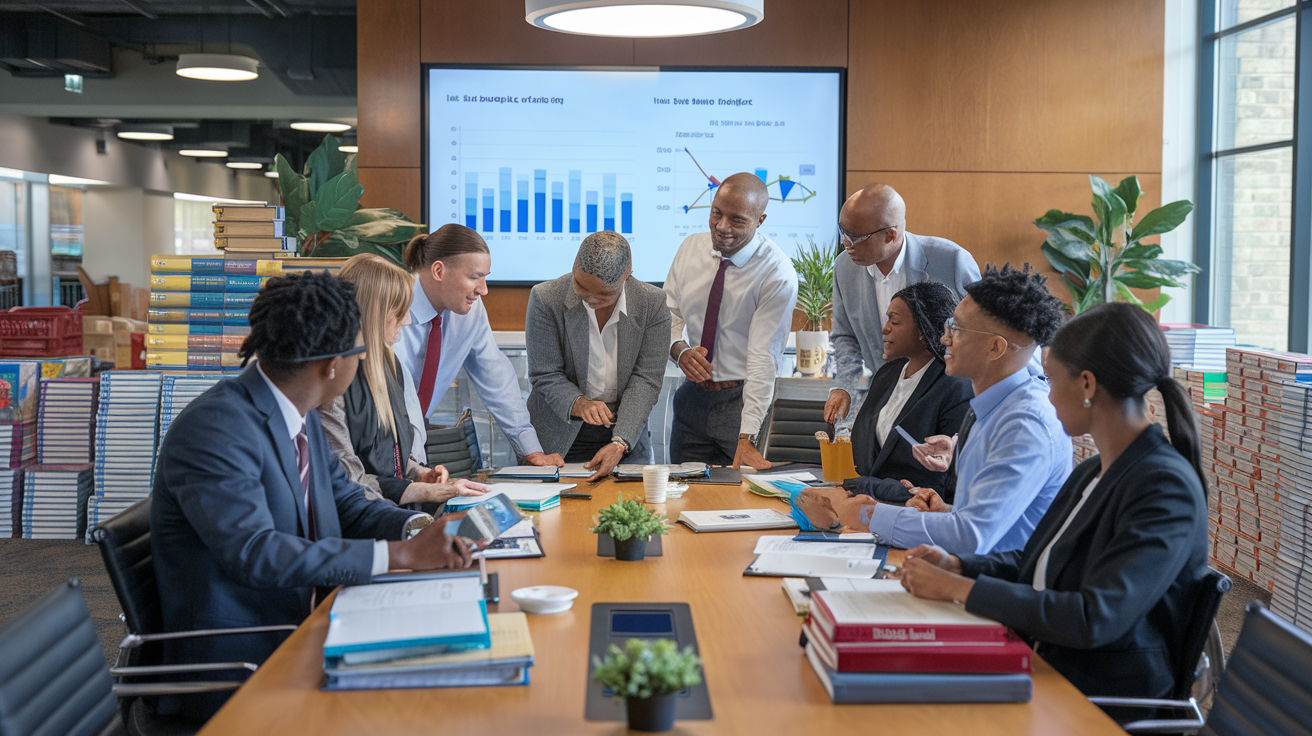Are you feeling the pinch of budget cuts at your school? 💸 You’re not alone. Educational institutions across the UK are grappling with tightened purse strings, leaving many administrators scratching their heads over how to maintain quality education with dwindling resources.
But what if we told you there’s a silver lining? 🌟 Imagine turning your school’s procurement process from a necessary expense into a profit-generating powerhouse. It’s not just a pipe dream—it’s a reality that innovative schools are already embracing with the help of expert procurement consultants.
In this blog post, we’ll delve into the transformative world of strategic procurement in education. From understanding the harsh realities of budget cuts to exploring how schools are revolutionising their purchasing practices, we’ll guide you through the steps to make your school’s procurement work harder for you. Get ready to discover how you can stretch your budget further, boost efficiency, and even generate additional income—all through smarter procurement strategies. Let’s explore how your school can not just survive, but thrive in these challenging financial times.
Understanding the Impact of Budget Cuts on Schools

Common areas affected by budget cuts
When schools face budget cuts, several critical areas often bear the brunt of these financial constraints:
- Staffing reductions
- Educational resources
- Extracurricular activities
- Facility maintenance
- Professional development
| Area Affected | Impact |
|---|---|
| Staffing | Larger class sizes, reduced support staff |
| Resources | Outdated textbooks, limited technology |
| Extracurriculars | Fewer sports, clubs, and artistic programmes |
| Facilities | Delayed repairs, reduced cleaning services |
| Development | Limited training opportunities for teachers |
Long-term consequences of financial constraints
The long-term effects of budget cuts can be far-reaching and detrimental to the overall educational experience:
- Decreased academic performance due to reduced individual attention
- Limited exposure to diverse subjects and experiences
- Increased teacher burnout and turnover
- Widening achievement gaps between socioeconomic groups
- Diminished ability to prepare students for higher education and careers
The need for innovative solutions
Given these challenges, schools must seek creative approaches to maximise their limited resources:
- Collaborative partnerships with local businesses
- Grant writing and fundraising initiatives
- Shared services with neighbouring schools
- Energy-efficient upgrades to reduce utility costs
- Streamlined procurement processes to reduce waste and inefficiencies
By exploring these innovative solutions, schools can mitigate the impact of budget cuts and maintain high-quality education. This leads us to examine how transforming procurement practices can become a powerful tool in addressing financial challenges.
Transforming Procurement into a Profit Centre

Identifying cost-saving opportunities
When transforming procurement into a profit centre, schools must first identify areas where cost savings can be realised. This process involves:
- Conducting thorough spend analysis
- Identifying high-spend categories
- Evaluating current supplier relationships
- Assessing internal processes for inefficiencies
By focusing on these areas, schools can uncover significant savings opportunities. For instance, a comprehensive review of utility contracts or office supplies purchasing may reveal immediate cost-reduction potential.
Streamlining purchasing processes
Efficient procurement processes are crucial for maximising savings. Schools can streamline their purchasing by:
- Implementing e-procurement systems
- Standardising product specifications
- Consolidating orders to reduce shipping costs
- Automating approval workflows
| Traditional Process | Streamlined Process | Benefits |
|---|---|---|
| Manual paperwork | Digital requisitions | Time savings, reduced errors |
| Multiple approvals | Automated workflows | Faster turnaround, improved compliance |
| Decentralised buying | Centralised procurement | Better spend visibility, increased leverage |
Negotiating better contracts with suppliers
Effective negotiation can lead to substantial savings. Schools should focus on:
- Understanding market rates and trends
- Developing long-term supplier relationships
- Negotiating volume discounts and rebates
- Exploring value-added services from suppliers
By adopting a strategic approach to supplier negotiations, schools can secure more favourable terms and conditions, ultimately contributing to their bottom line.
Leveraging bulk purchasing power
Collaboration is key when it comes to maximising purchasing power. Schools can:
- Form purchasing consortia with other institutions
- Participate in regional or national framework agreements
- Aggregate demand across departments or campuses
This collective approach not only reduces costs but also improves bargaining power, allowing schools to access better quality products and services at lower prices.
The Role of Expert Procurement Consultants

Specialised knowledge and industry insights
Expert procurement consultants bring a wealth of specialised knowledge and industry insights to the table, offering schools a significant advantage in their procurement processes. These professionals possess in-depth understanding of:
- Market trends
- Supplier landscapes
- Pricing strategies
- Contract negotiation techniques
Their expertise allows schools to make informed decisions and secure better deals across various categories, including:
| Category | Potential Savings |
|---|---|
| IT Equipment | 15-20% |
| Office Supplies | 10-15% |
| Catering Services | 8-12% |
| Energy Contracts | 5-10% |
Objective analysis of current procurement practices
Consultants provide an unbiased evaluation of existing procurement methods, identifying:
- Inefficiencies in the current system
- Opportunities for cost reduction
- Areas for process improvement
- Potential risks and compliance issues
This objective analysis forms the foundation for developing effective procurement strategies tailored to each school’s unique needs.
Tailored strategies for school-specific needs
Understanding that no two schools are alike, procurement consultants develop customised strategies that align with:
- School size and type
- Budget constraints
- Educational objectives
- Local community needs
These bespoke approaches ensure that procurement efforts are not only cost-effective but also support the school’s overall mission and values.
Implementation support and staff training
Beyond strategy development, consultants offer invaluable support during the implementation phase. This includes:
- Guiding staff through new procurement processes
- Providing hands-on training for procurement tools and technologies
- Assisting with supplier negotiations and contract management
- Offering ongoing support and troubleshooting
By empowering school staff with the necessary skills and knowledge, consultants help ensure long-term success and sustainability of the new procurement practices.
Key Strategies for Profitable Procurement

Conducting spend analysis
To transform procurement into a profit centre, schools must first understand their current spending patterns. Conducting a thorough spend analysis is crucial for identifying areas of inefficiency and potential savings. This process involves:
- Collecting data from all procurement sources
- Categorising expenses
- Analysing spending trends
- Identifying opportunities for cost reduction
A well-executed spend analysis can reveal surprising insights, such as:
| Insight | Potential Action |
|---|---|
| Duplicate suppliers | Consolidate vendors |
| Off-contract spending | Improve contract compliance |
| Maverick purchases | Implement stricter approval processes |
| Underutilised discounts | Negotiate better terms with suppliers |
Implementing e-procurement systems
E-procurement systems can significantly streamline the purchasing process, reducing administrative costs and improving efficiency. Benefits include:
- Automated requisition and approval workflows
- Real-time budget tracking
- Improved spend visibility
- Enhanced supplier management
Fostering supplier relationships
Building strong relationships with suppliers can lead to better terms, improved service, and innovative solutions. Schools should:
- Regularly communicate with key suppliers
- Collaborate on cost-saving initiatives
- Seek supplier input on product specifications
- Establish performance metrics for supplier evaluation
Exploring shared services with other schools
Collaboration between schools can unlock significant savings through economies of scale. Consider:
- Joint purchasing agreements
- Shared back-office functions
- Pooled resources for specialised services
Adopting sustainable procurement practices
Sustainability in procurement not only benefits the environment but can also lead to cost savings. Schools should focus on:
- Reducing energy consumption
- Minimising waste
- Choosing eco-friendly products
- Considering lifecycle costs in purchasing decisions
By implementing these key strategies, schools can transform their procurement function from a cost centre to a value-generating asset, helping to mitigate the impact of budget cuts while improving overall efficiency.
Overcoming Common Challenges in School Procurement

A. Resistance to change from staff
Implementing new procurement strategies often faces resistance from staff accustomed to traditional methods. To overcome this challenge:
- Communicate the benefits clearly
- Provide comprehensive training
- Involve staff in the decision-making process
- Celebrate early wins to build momentum
B. Limited resources and time constraints
Schools frequently grapple with resource limitations. Here are effective ways to manage this challenge:
- Prioritise high-impact procurement areas
- Leverage technology for efficiency
- Collaborate with other schools to share resources
- Outsource complex procurement tasks to experts
C. Balancing cost savings with quality considerations
Striking the right balance between cost-effectiveness and quality is crucial. Consider the following approach:
| Aspect | Strategy |
|---|---|
| Total Cost of Ownership | Look beyond initial price |
| Quality Metrics | Establish clear quality standards |
| Supplier Relationships | Build long-term partnerships |
| Value Analysis | Assess functionality vs cost |
D. Navigating complex regulations and compliance issues
School procurement is often subject to strict regulations. To navigate this complexity:
- Stay informed about current regulations
- Develop a comprehensive compliance checklist
- Seek expert advice for complex procurements
- Implement robust documentation processes
By addressing these common challenges head-on, schools can transform their procurement practices into a source of significant savings and efficiency. This approach not only helps mitigate the impact of budget cuts but also positions schools to thrive in an increasingly resource-constrained environment.

Schools facing budget cuts can transform their procurement processes into profit centres with the help of expert consultants. By implementing key strategies such as strategic sourcing, contract management, and supplier relationship optimisation, educational institutions can significantly reduce costs and even generate additional revenue. These approaches not only address immediate financial challenges but also create long-term sustainability for schools.
Embracing professional procurement practices is no longer a luxury but a necessity for schools in today’s economic climate. By partnering with expert procurement consultants, schools can navigate common challenges, leverage their buying power, and unlock hidden value within their supply chains. This proactive approach to procurement not only helps schools weather budget cuts but also positions them for future growth and success in delivering quality education.








